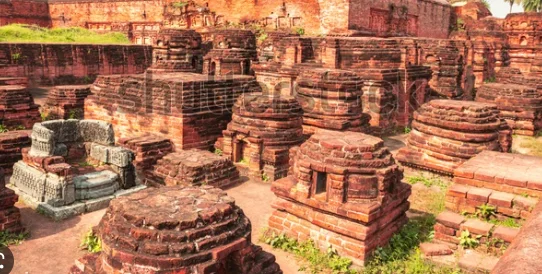History and Art and Culture
Context: Archeological Survey of India (ASI) has recently discovered two 1200-year-old miniature votive stupas during landscaping activities near Sarai Tila mound on the premises of ‘Nalanda Mahavihara’, a world heritage site in Nalanda district.
About Miniature votive stupas:
- A Stupa is a hemispherical structure which symbolizes the burial mound of Buddha. It rose to prominence after the advent of Buddhism and peaked during Ashoka’s reign. Stupas evolved as Chorten in Tibet and pagodas in East Asia.
- Archeologists suggest that the stupas must be around 1200 years old.

- During the beginning of 7th century CE, small miniature terracotta stupas became popular as votive offerings.
- Votive is the form of the stupa, with its distinctive domelike drum, originating in eight cylindrical structures in which the Buddha’s relics were placed after his death.
About Nalanda Mahavihara at Nalanda, Bihar
- The Nalanda Mahavihara site is in the State of Bihar, in north-eastern India.
- It comprises the archaeological remains of a monastic and scholastic institution dating from the 3rd century BCE to the 13th century CE.
- It includes stupas, shrines, viharas (residential and educational buildings) and important art works in stucco, stone and metal.
- Nalanda was established during the Gupta Empire era and was supported by numerous Indian and Javanese patrons – both Buddhists and non-Buddhists.
- The historical development of the site testifies to the development of Buddhism into a religion and the flourishing of monastic and educational traditions.
Source: Times of India
Previous Year Questions
Q.1) Consider the following pairs:
Historical place Well-known for
- Burzahom Rock-cut shrines
- Chandraketugarh Terracotta art
- Ganeshwar Copper artefacts
Which of the pairs given above is/are correctly matched?
- 1 only
- 1 and 2
- 3 only
- 2 and 3
Q.2) Which one of the following statements is correct?
- Ajanta Caves lie in the gorge of the Waghora river.
- Sanchi Stupa lies in the gorge of the Chambal river.
- Pandu – lena cave shrines lie in the gorge of the Narmada river.
- Amaravati Stupa lies in the gorge of the Godavari river.














